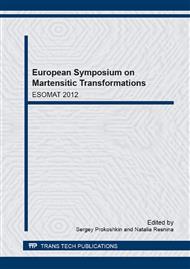p.344
p.348
p.352
p.357
p.362
p.367
p.372
p.377
p.383
Influence of Ultrasonic Treatment on Shape Memory Effects in Ti-50,4at.%Ni Alloy
Abstract:
In the present study we investigate the effect of ultrasonic treatment on the functional properties of Ti 50,4at.%Ni alloy after the processing in free and pre-deformed conditions. It is shown that the shape memory effect and its realization peculiarities depend on the parameters and conditions of ultrasonic influence. Ultrasonic treatment of preliminary deformed TiNi alloy in pre-deforming conditions promotes the reduction of strain restoring at the subsequent heating through the temperature interval of reverse martensite transformation. I. e. some setting of induced strain occurs during the ultrasonic treatment of material in pre-deforming conditions. In the specimens after ultrasonic treatment, it is observed the extension of shape recovery temperature range in the first thermal cycle, as well as the dependence of strain recovery temperature dynamics on the power of ultrasonic influence. Also it is established that ultrasonic treatment helps to increase the shape memory effect.
Info:
Periodical:
Pages:
362-366
Citation:
Online since:
January 2013
Keywords:
Price:
Сopyright:
© 2013 Trans Tech Publications Ltd. All Rights Reserved
Share:
Citation:


